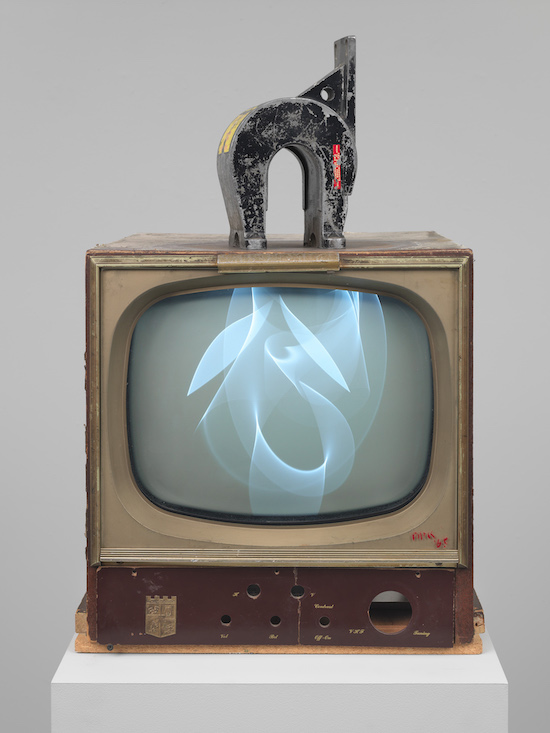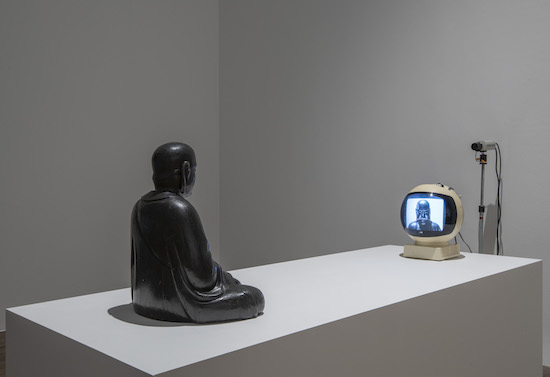TV Buddha 1974. Install view, Tate Modern 2019. All photographs: Andrew Dunkley ©Tate
Nam June Paik has been fossilised into book photographs or encoded into piles of flashing random TV sets in round robin Fluxus shows, where white noise blanked out content. As a media historian I had always desired to see his work but never got the chance to witness it first-hand. I wanted to feel the materiality of his original works, his 1960s, 1970s, 1980s television pieces. I was drawn into this exhibition by the lure of retro-technology.
A Korean artist who originally trained as a musician, Paik turned to avant garde antics. He was invited to join the 1960s Fluxus gang, and his performance art is documented here in multiple ephemera and actuality video. With musical innovators John Cage and Karlheinz Stockhausen leading cultural experiments in composition, he was another classical artist who moved from music into experimental art. Looking back at this movement it seems that audio and visual artists appeared to be pushing forward together.
This section, as an exhibit, is flat. The exciting history is more text book archive material stretched out and displayed in cabinets for the audience to imagine how amazing it was to have been there. The materiality of technology, and the service of the machines by practising experts and collectors who keep its flame alive, is necessary to appreciate Paik.
And I do, here. In person, I was stunned by the beauty of his television garden. Dozens of televisions glowing in the plants, in the dark, each one showing the same generated image in their various ways. The variety of the sets reminds me of the varieties of plants. They could be catalogued by Carl Linnaeus, their classification system would have a similar romance to the taxonomy of monandria and diandria.
And I think of the cathode ray technology. Those great warm, powerful fireplaces of picture were the hottest thing in our lounge which was quite austere. “Don’t sit too near the television,” warned my mother, concerned that we would be radiated. My brother in particular was drawn to the television, even tuning in to the signal from Wales so we could catch the episodes of The Prisoner that were screened in the 1970s.
They were dangerous, too – with the high voltages, the pressure that could shatter glass, emitting shards that might fly. Hot tension. I admired the television repairman. He could fix this world inside a box. I kept my distance in case death could leap across the room in a sudden bolt of lightning.

Magnet TV 1965. Whitney Museum of American Art, New York. Purchased, with funds from Dieter Rosenkranz
Nam June Paik, is, like me, seriously in love with the technology of the cathode ray tube. Its impossibilities. He is drawn to it, like the people of his generation, like a moth to a candle. He is sucked in by his eyes into its materiality. It is a different sensation to the cold LED light, the chill of the plasma screens, their sheeny flatness. There is a warmth, a softness, an electric hum at the heart of the cathode ray box. It is his appreciation of this that draws me in. Even though I am not a Buddhist, and this informs everything that Paik does, I appreciate the visceral symbolism. The lit candle inside the TV case is universally resonant. This was the domestic shrine of my generation.
Some art journalists seem to find it hard to write about this technology. It doesn’t have the cultural weight of paint. The manipulation of electrons by magnets is not as revered as expressive brushstrokes. The colours generated through moving particles in electro-magnetic fields is not as historically valid as rose madder and the various ground ochres. Paik gets compared unfavourably with other, ‘greater’ modern artists. The reviews I have read of the show by Jonathan Jones and others are uninterested in the television medium. Some are scathing and I wonder if they really think that his television art belongs in the Tate Modern at all. What is the modern art world coming too? Bricks were fine, but tellies? Low culture that must be resisted with scathing cultural intellect.
I laugh out loud to see the beautiful television robots. I’m from the generation of mothers that calmed their children with the Teletubbies. Well here is their adult prototype. Perhaps this is what he should be remembered for rather than his coinage of the term ‘electronic superhighway’. These life-size robots built from domestic technology acquired from thrift stores and markets.
Sadly, his collaborations with Charlotte Moorman, which I want so much to enjoy, sadden me. I’m delighted to see a female artist and a musician as a significant collaborator. But the sexualisation of her contribution, by herself and others, the description she gets saddled with, for obvious reasons, as the ‘topless cellist’, excludes me and makes me want to flee from the sexism. Her light bulb bikinis, the bras of TV screens seem pointless gesturing. As a female artist I want to step away from the image of myself. Is this the kind of thing I have to do to have my work taken seriously? I certainly felt this, unconsciously, in my early reactions to this part of their joint oeuvre. Her presence is evoked by her clothes hanging from the ceiling. Yet another female artist who is represented by her wardrobe. What is different to this and cabinets of Princess Diana’s costumes? We don’t represent Nam June Paik by hanging up one of his suits.
Moorman also excludes me with her opinions taken from the classical school. The quotations selected by the curator for the wall seem to be to be at odds with the Fluxus attitude. You have to know, I paraphrase her here, the rules in order to break them. So those of us who didn’t go to a prestigious conservatoire like Julliard to get our musical education don’t know how to break rules properly?
I leave the exhibition thinking about the Buddha watching the TV through a closed-circuit camera. Like Marina Abramovic, I think, contemplating her eye-to-eye scenarios like ‘The Artist Is Present’ in which she at in MOMA New York and Belgrade, staring into the face of visitors for periods of endurance. But unlike Abramovic, whose performance becomes all about human breakdown, the moments of uncontrollable laughter and tears, the technology gives the Buddha statue the envelope of eternity. Staring into his own eyes, the Buddha meets his equal due to the magic of television. He’s trapped too, in time and space. See yourself in the TV. We’re looped, looped, looped together in one eternal moment.
Nam June Paik is at Tate Modern, London, until 9 February 2020


